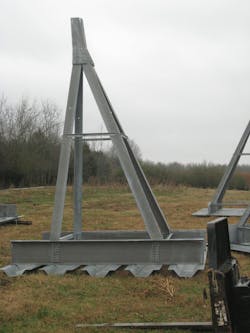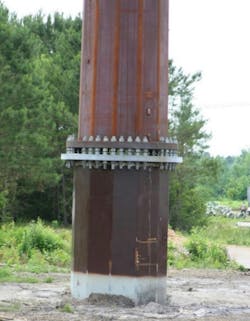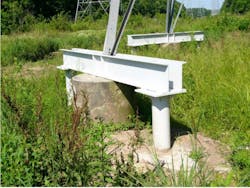From Soil to Structure: Best Practices for Utility Foundations in a Changing Climate
Key Highlights
- The ASCE manual provides a unified standard for foundation design, reducing variability and unnecessary costs across utilities.
- It promotes modern approaches like Reliability-Based Design (RBD) to balance safety and cost-efficiency in foundation engineering.
- Emphasizing geotechnical exploration, the manual guides thorough soil investigation to prevent future failures and redesigns.
- Special foundation solutions such as vibratory caissons and micropiles are highlighted for challenging environments like wetlands and rocky terrains.
- Guidance on retrofitting and corrosion protection ensures existing infrastructure remains reliable amid aging and environmental threats.
Foundations are a critical part of the grid, but they are hidden from view. It’s the old out of sight, out of mind saying that comes to mind whenever the subject comes up. Consider, however, when an overhead powerline pole leans or a latticed tower shifts, the problem usually starts below ground. Foundations may be invisible, but they determine whether the grid stands strong or fails under extreme weather.
Without consistent foundation design standards for the overhead power line and substation industry, utilities have faced a patchwork of practices and unpredictable outcomes. A new Manual of Practice (MOP) from the American Society of Civil Engineers (ASCE) aims to change that. It is offering best practices guidance document for anchor reliability from the ground up.
For decades, the electric utility industry lacked a uniformly accepted standard for analyzing and designing these foundations and then global climate change with its extreme weather events changed everything! Practices varied between regions and utilities, leading to inconsistent reliability, higher costs, and, in some cases, unexpected failures.
Recognizing this gap, the ASCE task committee on the Design of Overhead Power Line and Substation Foundations developed the first MOP devoted entirely to overhead power line and substation foundations. Drawing from surveys, research, and decades of field experience, MOP offers utilities a comprehensive guide to best practices.
By consolidating decades of research, survey results, and practical experience, the latest ASCE MOP gives utilities a roadmap for foundation design that is consistent, reliable, and ready for the future.
Why It Matters
The new ASCE manual doesn’t just dive into equations and soil mechanics — it tells the story of what really makes foundations succeed or fail. It starts with the basics of overhead power line and substation design, then walks readers through the choices every utility must make.
From there, it goes deeper — literally — into the ground. The story explains how geotechnical exploration, like test borings and soil sampling, feeds into smarter designs. Factors like what type of foundation to use, or what type of load it must carry are important. Even something like what design philosophy makes foundations more reliable play an important part of that story.
What makes this story unique is its balance between the familiar and the specialized. It covers conventional options like drilled shafts, shallow foundations, and direct-embedded poles — the workhorses of the industry — but also shines light on specialty approaches such as vibratory caissons, helical piles, and micropiles, which can save the day in tough soils.
It also offers practical advice on construction aspects, so that what looks good on paper actually performs in the field.
Rather than leaving engineers with scattered “best practices,” MOP weaves them into a roadmap: clear guidance that utilities can actually apply in the field, whether they’re reinforcing a tower in flood-prone wetlands or anchoring a substation on rocky ground.
Consistency Was Needed
The electric grid is expanding rapidly, but foundation design practices remain fragmented and inconsistent. The foundations that carry power lines and substations face challenges very different from those of buildings or bridges. Yet, unlike the building and transportation industries, transmission still lacks a single, modern manual that brings everything together. There’s no unified code that speaks directly to the wide range of foundation types used to keep electrical structures standing strong.
ASCE MOP task committee survey revealed striking inconsistencies in how foundations are designed. Without clear consensus, utilities often end up with overdesign, as each step in the design–bid–build process adds extra safety factors for the same uncertainties. The result is unnecessary conservatism that drives up costs.
The new ASCE Manual of Practice changes that. It sets a consistent baseline for design methods, geotechnical practices, and performance criteria — helping reduce risk, cut waste, and modernize foundation design for today’s evolving grid.
Shifting Design Philosophy
The new manual promotes modern approaches like Reliability-Based Design (RBD) for the deep foundations, which bring science to what was once largely guesswork. A simplified version, Load and Resistance Factor Design (LRFD), assigns strength factors to account for uncertainties in capacity calculations. For decades, utilities relied on Allowable Stress Design (ASD), which applies safety factors. Selecting an adequate safety factor requires considerable professional judgment and experience and can vary significantly among foundation designers; consequently, the reliability of foundations designed using ASD can be highly variable.
RBD takes a more refined approach. By quantifying risk, it adjusts strength factors to reflect actual conditions, showing where a smaller foundation is sufficient and where a stronger one is essential. This balances costs against risk, giving engineers confidence in performance and managers some assurance that investments are spent wisely. In short, ASD is “one-size-fits-all,” while RBD is “fit-for-purpose.” For shallow foundations, RBD approaches can complement ASD, helping utilities avoid both overdesign and underperformance.
Geotechnical Exploration
The new ASCE manual puts strong emphasis on geotechnical exploration. It calls for a layered approach. It starts with desktop studies of maps and geology. Those are followed by field investigations such as test pits or borings. Then it is all confirmed with laboratory tests to understand soil strength and behavior. Each step adds another piece to the puzzle, reducing uncertainty and sharpening the design.
The MOP provides a comprehensive summary of soil and rock properties, along with their associated geotechnical design parameters.
The payoff is clear. For utilities, it means fewer mid-project redesigns, fewer surprises in the field, and foundations that perform as expected when the next storm hits.
Foundations Differ
Direct-embedded poles remain the workhorse of overhead power lines. Users need to take into consideration the requirements of embedment depths. In addition, there are limitations to predetermined depth methods, which is where the MOP is so valuable.
MOP cautions that determination of embedment depth alone isn’t enough. Depending on whether sand, gravel, or native soil is used, the backfill can control foundation capacity. Foundations may fail in the backfill, the surrounding native soil, or both. The manual provides guidance for analyzing these interactions.
Drilled shafts are a mainstay of utility construction because they can handle both the heavy vertical weight of a structure and the strong lateral forces it faces in service. How much movement a shaft is expected to undergo — its side-to-side displacement and rotation — plays a big role in both the performance and cost of the foundation. The MOP offers a more balanced design approach that helps engineers set realistic limits: firm enough to prevent significant movement under maximum loads, but not so conservative that it drives up costs without adding real value.
The MOP also underscores the importance of getting construction right the first time. Non-Destructive Integrity Testing (NDIT) is highlighted as a best practice to verify concrete shafts are free of defects before they go into service. That assurance is critical, since repairing a defective shaft after installation is extremely difficult and costly.
At first glance, shallow foundations sound straightforward. After all, they sit close to the surface and are often the first choice for supporting substation equipment like transformers, breakers, or control houses. But “simple” doesn’t always mean “easy.”
One challenge comes from the way equipment loads are applied. Imagine trying to balance a heavy box on a seesaw — if the weight isn’t centered, the pressure beneath shifts unevenly. Shallow foundations sometimes face a similar problem when loads are off-center, creating uneven stress in the soil below.
The soil itself can pose another risk. A utility once discovered that a new control house door wouldn’t shut properly. The cause wasn’t the hinges — it was the foundation slowly settling into soft soil. If the near-surface material is weak or compressible, the foundation may slowly sink or tilt over time, much like a chair leg sinking into soft ground. Careful planning and soil investigation are essential to avoid costly settlement problems.
From uplift to compression to lateral loading, the new MOP highlights how to evaluate shallow foundations under the full range of forces they face, ensuring both reliability and cost-effectiveness.
Anchors
Anchors are a critical part of keeping structures stable, and they come in many forms — from steel plates and screw-like helicals to grouted and buried systems. Their performance depends on several factors, including soil conditions, geometry, and installation angle. Because no two sites are the same, design decisions can’t be left to guesswork. The new MOP gives engineers practical guidance on when straightforward approaches are sufficient and when more advanced analysis is needed to ensure both safety and cost-effectiveness.
Special Foundations & Conditions
Not every transmission line crosses firm, level ground. Many are built in wetlands, floodplains, mountains, or remote corridors where standard foundations simply don’t work. In these environments, engineers rely on creative solutions. Vibrated steel caissons perform in high-water sites where soil removal must be limited, while helical piles — giant screw-like anchors — are often the choice in coastal regions where uplift resistance is critical.
One project in the Blue Ridge Mountains showed just how adaptable these methods can be. After a landslide cut off access, crews stabilized towers with slender micropiles drilled into rock and tied into a surface grillage. The system provided deep support with a small footprint, protecting both reliability and the surrounding environment. As reported in T&D World in May 2023, it became a model of how urgent fixes can inspire long-term best practices.
The MOP captures these lessons, combining design guidance with construction know-how to help engineers apply the right solution in the field. It also highlights that foundations rarely sit in ideal soil. Frost, erosion, and human activity can weaken support; in some cases, frozen ground has even caused tower failures, as seen in Ontario in 2008. Add to this the risks of landslides, avalanches, adjacent excavations and slopes, underground utilities, or even stray currents on buried steel, and the picture becomes clear: successful projects depend on adapting to the site, not just following a standard recipe.
Extending Guidance
Although full seismic analysis is rarely performed for transmission structures, earthquakes can still cause foundation failures through landslides or liquefaction. MOP offers practical guidance, summarizing code references, modeling approaches, and reinforcement details, while also outlining strategies to mitigate liquefaction, settlement, and lateral spreading.
Utilities also face the challenge of reusing and upgrading existing foundations. When loads increase due to system upgrades or when deterioration is discovered, retrofits may be required. The MOP provides a systematic way to evaluate older foundations and recommends reinforcement or refurbishment methods to ensure they can safely carry new demands.
The appendices add further practical resources: survey results on current utility practices, corrosion protection strategies, guidance on concrete and grout, and anchorage design procedures. Corrosion in particular has proven costly — for example, a T&D World article in November 2021 described severe groundline corrosion on steel poles that required reinforcement and replacement to restore structural capacity. By highlighting such risks, MOP equips engineers with both preventive measures and corrective approaches to safeguard reliability.
Building for the Future
The electric grid faces unprecedented demands: renewable integration, climate resilience, aging assets, and evolving regulations. The strength of foundations plays a significant role in the reliability of overhead power line structures and substations.
By consolidating decades of research, survey results, and practical experience, the latest ASCE MOP gives utilities a roadmap for foundation design that is consistent, reliable, and ready for the future.
As one task committee member noted: “Every pole and tower starts in the ground. With this manual, we now have the tools to build reliability from the bottom up.”
About the Author
Prasad Yenumula
Dr. Prasad Yenumula is a principal engineer at Duke Energy. He is the chair of the Line Design task force of EPRI and the past chair of the CEATI-TODEM interest group. He is active in various other industry organizations such as ASCE, NESC, EEI, DFI, and ANSI C29. Yenumula is also a professor (adjunct) at Gonzaga University. He is a founding faculty member of the T&D engineering Masters program. He recently co-authored a textbook on transmission line structures and foundations.




